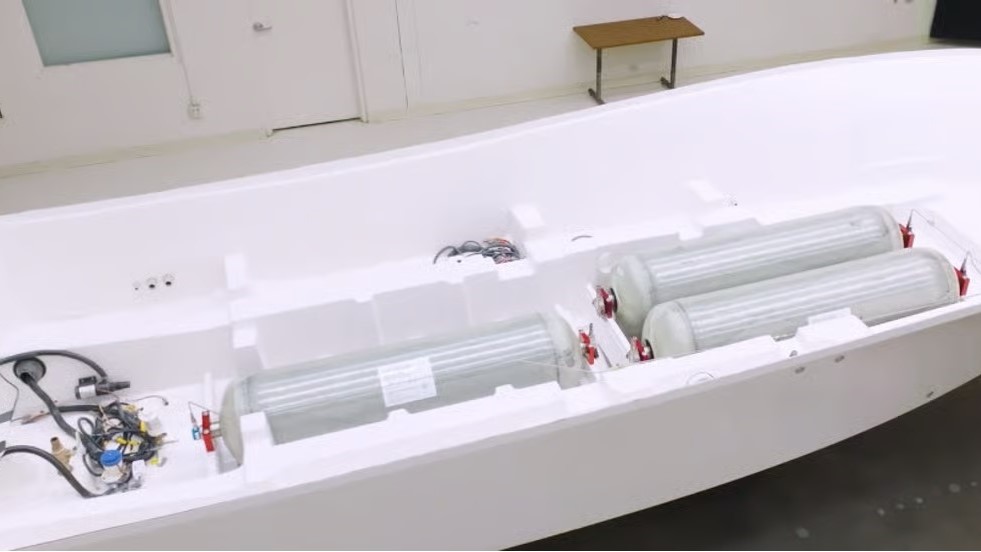Yamaha previously announced it would show its prototype hydrogen-combustion outboard motor at the 2024 Miami International Boat Show, and it’s gone the extra mile in bringing a prototype boat and fuel delivery system to go along with it. Yamaha calls its new hydrogen V8 outboard a world first for the recreational boating industry and has partnered up with Roush and Regulator Marine to install it into a working boat that will begin testing in a few months.
In developing its hydrogen outboard prototype, Yamaha adapted the technology it has used for land-based hydrogen combustion engines, including the one it installed on the Drive H2 golf cart concept revealed last month at the PGA Show. In this case, it created a hydrogen version of its flagship XTO outboard, an offshore V8 offering 425- and 450-hp ratings, the most powerful in Yamaha’s outboard lineup. Yamaha has not released output specs for the hydrogen version, so we’re not sure how close it comes to joining the gas XTO at the top of the Yamaha outboard family.
According to its designer, Tilt4orce takes its name from the fact that its tilt apparatus “applies mechanically advantaged human force to four locations on the rear swingarms to pivot them up and down, creating the parallel tilting of the main frame and wheels”
Building a combustion engine that can run on hydrogen is but one part of the equation; another major challenge is figuring out how to store and run the H2 to fuel it. For this aspect of the project, Yamaha turned to the experts at Roush for help.
The Roush name rings familiar to us primarily from its performance automotive division and Ford Mustang models and components, but the greater company includes engineering and clean tech arms that work in a wide variety of industries, from mobility and aerospace, to energy and defense. It has decades of experience working with hydrogen power systems across various sectors.
Roush worked closely with boatbuilder Regulator Marine in integrating its fuel system into the prototype boat. Regulator started out with the 26.8-foot (8.2-m) hull from its 26XO sport fishing boat, immediately redesigning around the very different storage requirements of hydrogen versus gas.
Since the boat is designed to be a working prototype and testbed, not merely an exhibition vehicle, Regulator’s work wasn’t always simple. It had to relocate bulkheads and other critical elements around the large compressed-hydrogen tanks to ensure full structural integrity. The tanks sit low and centrally and take up a lot of space that would ordinarily be assigned to components like the center console, fish box and marine head.
Yamaha, Roush and Regulator plan to begin testing of the prototype boat this summer (Northern Hemisphere). All three are keen to test the viability of a hydrogen combustion system in the marine environment with an eye toward the future of boating.
For its part, Yamaha has committed to pursuing a multi-solution approach to decarbonization in recreational boating. It’s hit the ground running this year in accordance with that multi-source plan, the hydrogen prototype following on the heels of its announcement last month of intent to acquire German electric propulsion specialist Torqeedo. It hopes to lead the way in marine hydrogen development while encouraging competitors to proceed with H2 plans of their own and contribute to the greater marine hydrogen ecosystem.
Tags: Boat, Hydrogen, Regulator Marine, Roush, Yamaha



Recent Posts
Goltens Partners with Orcan Energy to Expand Marine Waste Heat Recovery Solutions
NWSA Launches First Incentive Program for Zero Emission Trucks in Washington
IHI and Vopak Partner on Ammonia Terminal Development in Japan
Chimbusco Pan Nation Completes First B30 Marine Gasoil Delivery in Hong Kong
ITOCHU Announces Newbuilding Order for Ammonia Bunkering Vessel
India Launches Incentive Scheme for Electric Trucks under PM E-DRIVE Initiative
Royal Caribbean Welcomes LNG-Fueled Star of the Seas to Its Fleet
Swire Shipping Launches ‘Voyage to Zero’ to Help Customers Cut Scope 3 Emissions Swire